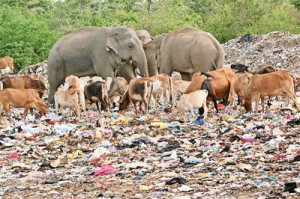News
Deadly garbage dumps pose elephantine problems

Agonising death: The elephant which died after suffering for more than a month after eating garbage at Manampitiya. Pic by Karunaratne Gamage
An elephant which had been regularly eating garbage at Manampitiya died last Saturday after suffering from a sickness for a month.
This well grown male, about 20 years of age, was part of a herd that fed on garbage from a dump at Manampitiya. It had fallen ill in the third week of January. A veterinary surgeon and a team of wildlife officers tried to flush out any non-digestive materials from its stomach. One even inserted a hand through its anus to manually pull anything that remained. At first they pulled out about 15 kilograms of polythene in a day and over a month about 30 kilograms were removed.
Dr Pramuditha Devasurendra who had treated the elephant, rejected the idea that the polythene was the cause of death. He said toxic bacteria in rotting food may have been the cause. “The garbage pit contains lots of lunch sheets with rotten food. Deadly bacteria can grow on the food. This is main reason for the death of the elephant.”
Dr Devasurendra revealed that a post-mortem did not find any polythene in the bowels of the dead elephant. Its liver and spleen were damaged.
He said he had treated another elephant about half a kilometre away from the garbage dump at Manampitiya. “That elephant too died and I have been unfortunate to witness deaths of at least 10 elephants since I assumed duties in this area four years ago,” Dr Devasurendra said.
The Manampitiya dump is not the only one that attracts elephants. A garbage dump in Dambulla attracts elephants. Yet another dump in Hambantota is protected by an electric fence.
Dr. Devasurendra said an electric fence was needed at Manampitiya.
Meanwhile, Dr Prithiviraj Fernando, estimates that there are at least 50 locations where elephants come to forage at the dump. They are mostly in the dry zone.
Dr Fernando said piles of vegetables, over ripe fruit, flour, rice, bread and the like are more nutritious than what is found naturally. Elephants which rummage for these at the dumps are in better health, he said.
But he said every day 500 elephants may be eating garbage. “In a year, how many of them would die as a result? How does this compare with other ‘unnatural’ causes of elephant deaths? Such as being shot, hakka patas, injuries from trap guns and nooses, train or vehicle accidents, starving to death inside parks after being driven in and restricted with electric fences,” he asks.
It is mostly adult males living outside Wildlife Department protected areas that eat garbage.

The Manampitiya dump: Veritable death trap for wild animals. Pic by Kanchana Kumara
This also means the elephants are not raiding farms. So if they are to be prevented from raiding garbage dumps would it increase the human elephant conflict, and how many of them would be injured and killed? And how many people would be injured and killed? Dr Fernando asks.
“So before jumping in and trying to ‘fix’ something one should first find out what the problem is, figure out the cost and benefit of ‘fixing’ and make an informed decision. Otherwise the cure may be worse than the disease,” he warns.
Dr. Fernando suggests separating the organic matter from the plastics, metals, and glass materials before being dumped.

